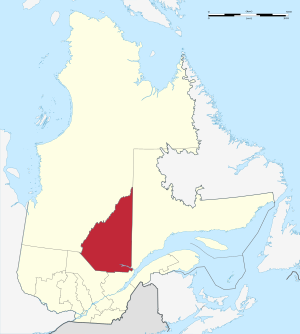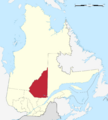Saguenay–Lac-Saint-Jean facts for kids
Quick facts for kids
Saguenay–Lac-Saint-Jean
|
||
|---|---|---|
|
Région
|
||
|
||

Saguenay–Lac-Saint-Jean's location in comparison to the whole Canadian province of Quebec.
|
||
| Country | ||
| Province | ||
| Area | ||
| • Total | 98,712.71 km2 (38,113.19 sq mi) | |
| Population
(2016)
|
||
| • Total | 276,368 | |
| • Density | 2.799721/km2 (7.251243/sq mi) | |
| Time zone | UTC−5 (EST) | |
| • Summer (DST) | UTC−4 (EDT) | |
| Website | Tourism Saguenay-Lac-Saint-Jean | |
Saguenay–Lac-Saint-Jean is a large region in Quebec, Canada. It's often called Sagamie too. This name comes from "Saguenay" and "Piekouagami," which is the Innu name for Lac Saint-Jean. "Piekouagami" means "flat lake."
This region is famous for its beautiful Saguenay Fjord and the Saguenay River. These waterways are very important to the area's history and how it has grown. Saguenay–Lac-Saint-Jean is the third-largest region in Quebec. It covers a huge area of about 98,712 square kilometers (38,113 square miles). The southern part of the region has fertile land, surrounded by forests and mountains. Many tourists visit Saguenay–Lac-Saint-Jean each year to enjoy its amazing scenery and fun activities. Lac Saint-Jean is a very popular spot for summer vacations.
Contents
What Does Saguenay Mean?
The name Saguenay might come from an Innu word, "Saki-nip." This word means "where water flows out."
Who Lives Here?
In 2021, about 275,552 people lived in the Saguenay–Lac-Saint-Jean region. This is about 3.2% of all the people in Quebec. Most people live in a few main cities:
- Saguenay is the biggest city, with about 144,723 people. It's located near the fjord.
- Alma has about 30,331 people.
- Other important towns include Roberval, Saint-Félicien, and Dolbeau-Mistassini.
Most people in the region speak French as their first language, about 98%. A small number of people speak English or other languages. About 5.1% of the population are Indigenous peoples.
The Flag of Saguenay–Lac-Saint-Jean
The flag of Saguenay–Lac-Saint-Jean was created in 1938. This was 100 years after the first settlers arrived in 1838. A local historian, Mgr. Victor Tremblay, designed it.
The flag has four colors, and each color represents something important about the region:
- The grey cross stands for aluminum. This metal is a very important product made in the region.
- The red border shows the hard work of the people who live there.
- The green at the top represents the large forests.
- The yellow at the bottom stands for farming and agriculture.
How the Region is Organized
The Saguenay–Lac-Saint-Jean region has 49 different areas called municipalities. This includes some areas that are not organized into towns.
Regional County Municipalities
The region is divided into smaller areas called Regional County Municipalities. These help manage local services.
- Le Fjord-du-Saguenay Regional County Municipality (about 21,600 people)
- Lac-Saint-Jean-Est Regional County Municipality (about 52,741 people)
- Le Domaine-du-Roy Regional County Municipality (about 31,285 people)
- Maria-Chapdelaine Regional County Municipality (about 24,793 people)
Main City
- Saguenay is considered an "equivalent territory" because it's a large city that acts like its own regional county municipality. It has about 144,746 people.
Native Reserve
- Mashteuiatsh is a reserve for the Montagnais people. It is located within Le Domaine-du-Roy area and has about 2,213 residents.
Major Communities
Here are some of the main towns and cities in the Saguenay–Lac-Saint-Jean region:
- Albanel
- Alma
- Dolbeau-Mistassini
- Hébertville
- Métabetchouan-Lac-à-la-Croix
- Normandin
- Roberval
- Saguenay
- Saint-Ambroise
- Saint-Bruno
- Saint-David-de-Falardeau
- Saint-Félicien
- Saint-Honoré
- Saint-Prime
Schools in the Region
The region has different school service centers that manage schools.
- Centre de services scolaire de la Jonquière
- Centre de services scolaire du Lac-Saint-Jean
- Centre de services scolaire du Pays-des-Bleuets (covers Maria-Chapdelaine, Le Domaine-du-Roy, Mashteuiatsh, and Saint-Ludger-de-Milot)
- Centre de services scolaire des Rives-du-Saguenay (covers most of Le Fjord-du-Saguenay and Saguenay city, except Jonquière)
All schools in the region that teach in English are part of the Central Quebec School Board.
Images for kids
See also
 In Spanish: Saguenay–Lac-Saint-Jean para niños
In Spanish: Saguenay–Lac-Saint-Jean para niños
- List of Quebec regions
- List of people from Saguenay-Lac-Saint-Jean
- List of historic places in Saguenay-Lac-Saint-Jean




